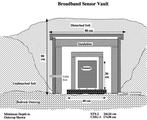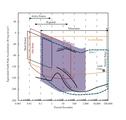
Introduction:
The construction of the vault for broadband seismometers has a direct impact on the data quality. The principle of broadband sensor vault design is to minimize temperature changes, and to distance the sensor pad from the surficial layer which tilts due to temperature, precipitation, solar insolation, wind, etc.
Nearby sources of ground noise, like footsteps or acoustic noise, are reduced by shallow burial (2-5 ft.) The construction must be adapted to the site and materials available. A decision will have to be made to balance the cost and labor of different vault designs against the length of deployment, resources available, and quality of data expected.
Finding a pre-existing enclosure is a tremendous savings in time and effort. This might include missile silos, power stations, abandoned mines, caves, or root cellars. Consider the details of cables, power, and locating a GPS antenna for timing at these sites.




